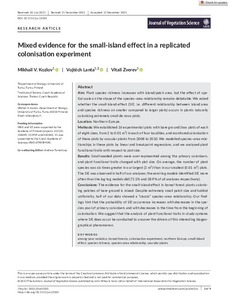| dc.contributor.author | Zverev Vitali | |
| dc.contributor.author | Kozlov Mikhail V | |
| dc.contributor.author | Lanta Vojtěch | |
| dc.date.accessioned | 2022-10-27T12:09:51Z | |
| dc.date.available | 2022-10-27T12:09:51Z | |
| dc.identifier.uri | https://www.utupub.fi/handle/10024/156716 | |
| dc.description.abstract | <p><br></p><p>Aim <br></p><p>Plant species richness increases with island/patch area, but the effect of spatial scale on the shape of the species-area relationship remains debatable. We asked whether the small-island effect (SIE; i.e. different relationship between island area and species richness on smaller compared to larger plots) occurs in plants naturally colonising extremely small de novo plots. <br></p><p>Location <br></p><p>Northern Europe. <br></p><p>Methods <br></p><p>We established 16 experimental plots with bare ground (two plots of each of eight sizes, from 2 to 0.01 m(2)) in each of four localities, and monitored colonisation of these plots by vascular plants from 2008 to 2010. We modelled species-area relationships in these plots by linear and breakpoint regressions, and we analysed plant functional traits with respect to plot size. <br></p><p>Results <br></p><p>Small-seeded plants were over-represented among the primary colonisers, and plant functional traits changed with plot size. On average, the number of plant species was six times greater in our largest (2 m(2)) than in our smallest (0.01 m(2)) plots. The SIE was observed in half of our analyses; the semi-log models identified SIE more often than the log-log models did (71.1% and 28.9% of all analyses respectively). <br></p><p>Conclusions <br></p><p>The evidence for the small-island effect in boreal forest plants colonising patches of bare ground is mixed. Despite extremely small patch size and habitat uniformity, half of our data showed a "classic" species-area relationship. Our findings hint that the probability of SIE occurrence increases with decreases in the species pool of primary colonisers and with decreases in the time from the beginning of colonisation. We suggest that the analysis of plant functional traits in study systems where SIE does occur be conducted to uncover the drivers of this interesting biogeographical phenomenon.</p> | |
| dc.language.iso | en | |
| dc.publisher | WILEY | |
| dc.title | Mixed evidence for the small-island effect in a replicated colonisation experiment | |
| dc.identifier.url | https://doi.org/10.1111/jvs.13103 | |
| dc.identifier.urn | URN:NBN:fi-fe2022081153784 | |
| dc.relation.volume | 33 | |
| dc.contributor.organization | fi=ekologia ja evoluutiobiologia|en=Ecology and Evolutionary Biology| | |
| dc.contributor.organization-code | 2606402 | |
| dc.converis.publication-id | 174886433 | |
| dc.converis.url | https://research.utu.fi/converis/portal/Publication/174886433 | |
| dc.identifier.jour-issn | 1100-9233 | |
| dc.okm.affiliatedauthor | Zverev, Vitali | |
| dc.okm.affiliatedauthor | Kozlov, Mikhail | |
| dc.okm.affiliatedauthor | Lanta, Vojtech | |
| dc.okm.discipline | 1181 Ecology, evolutionary biology | en_GB |
| dc.okm.discipline | 1181 Ekologia, evoluutiobiologia | fi_FI |
| dc.okm.internationalcopublication | international co-publication | |
| dc.okm.internationality | International publication | |
| dc.okm.type | Journal article | |
| dc.publisher.country | Yhdysvallat (USA) | fi_FI |
| dc.publisher.country | United States | en_GB |
| dc.publisher.country-code | US | |
| dc.relation.articlenumber | e13103 | |
| dc.relation.doi | 10.1111/jvs.13103 | |
| dc.relation.ispartofjournal | Journal of Vegetation Science | |
| dc.relation.issue | 1 | |
| dc.year.issued | 2022 | |
